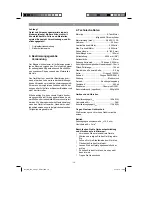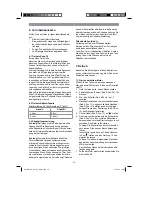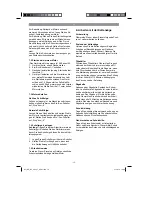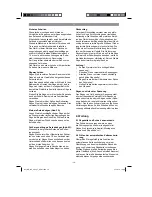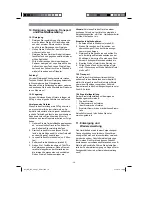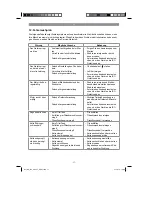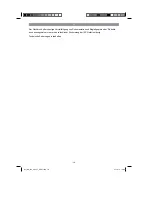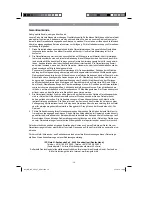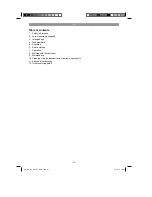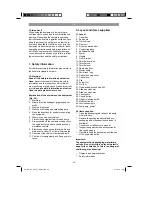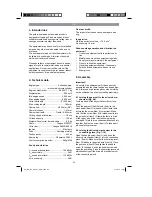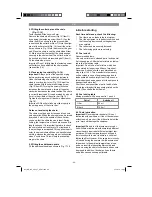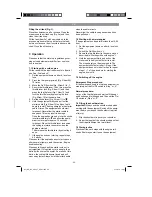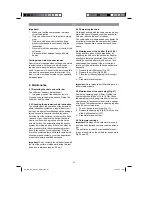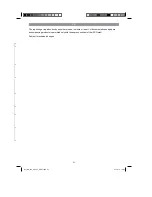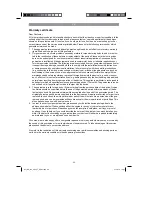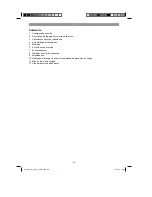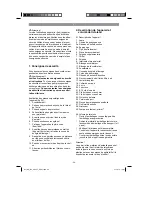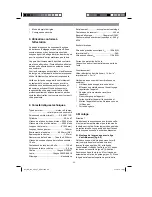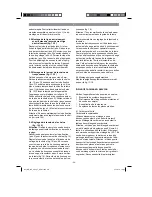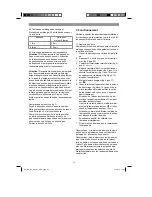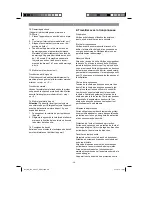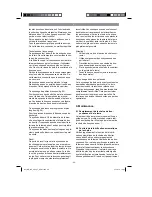
GB
- 24 -
5.3 Fitting the cutter bar and the chain
(Fig. 11-16)
Tools required: Allen key size 5mm
Remove the chain wheel cover (Fig.13/ Item O)
by undoing the fastening screw (Item P). Lay the
chain (Item 2) as shown into the groove which
runs around the cutter bar (Item 1). Note the align-
ment of the chain teeth (Fig. 12). Insert the cutter
bar as shown in Fig. 12 into the mount at the gear
unit. Place the chain round the chain wheel (Item
S). Make sure that the teeth of the chain engage
securely in the chain wheel. The cutter bar must
be hooked into the chain tensioning bolt (Item L).
Fit the chain wheel cover.
Important! Do not fully tighten the fastening screw
until after you have adjusted the chain tension
(see section 5.4).
5.4 Tensioning the chain (Fig. 14-16)
Important!
Always pull out the spark boot plug
before performing any checks or adjustments.
Undo the fastening screw (Item P) of the chain
wheel cover by a few turns (Fig. 13). Adjust the
chain tension with the chain tensioning screw
(Fig. 15/Item M). Turning the screw clockwise
increases the chain tension, turning it counter-
clockwise decreases the chain tension. The chain
is correctly tensioned if it can be raised by around
2 mm in the middle of the cutter bar (Fig. 14).
Tighten the
fi
xing screw of the chain wheel cover
(Fig. 16).
Important! All the chain links must lie properly in
the guide groove of the cutter bar.
Notes on tensioning the chain:
The chain must be properly tensioned to ensure
safe operation. When the saw chain can be raised
by around 2 mm in the middle of the cutter bar,
you know that the chain tension is ideal. During
cutting, the temperature of the chain rises and its
length changes. It is important therefore to check
the chain tension at least every 10 minutes and
to adjust it again as required. This applies in parti-
cular to new saw chains. When you have
fi
nished
working, slacken the chain again as it will shorten
when it cools down. This will help to prevent da-
mage to the chain.
5.5 Fitting the additional handle
Fit the additional handle as shown in Fig. 17-18.
6. Before starting
Each time before use, check the following:
•
That there are no leaks in the fuel system.
•
That the equipment is in perfect condition and
that the safety devices and cutting devices
are complete.
•
That all screws are securely fastened.
•
That all moving parts move smoothly.
6.1 Fuel and oil
Recommended fuels
Use only a mixture of unleaded petrol and special
2-stroke engine oil. Mix the fuel mixture as indica-
ted in the fuel mixing table.
Important: Do not use a fuel mixture which has
been stored for longer than 90 days. Important:
Never use 2-stroke oil with a recommended mi-
xing ratio of 100:1. The manufacturer’s warranty
will be voided in case of engine damage due to
inadequate lubrication. Important: Only use con-
tainers designed and approved for the purpose to
transport and store fuel.
Pour the correct quantities of petrol and 2-stroke
oil into the mixing bottle (see scale printed on the
bottle). Then shake the bottle well.
6.2 Fuel mixing table
Mixing procedure: 40 parts petrol to 1 part oil
Petrol
2-stroke oil
1 liter
25 ml
5 liters
125 ml
6.3 Chain lubrication
Important!
Never operate the chain if it is not
lubricated with saw chain oil. Use of the chainsaw
without saw chain oil or if the oil level is below the
„min“ mark will damage the chainsaw.
Important!
Be aware of the temperature condi-
tions: Di
ff
erent lubricants with completely di
ff
erent
viscosities are required at di
ff
erent ambient tem-
peratures. At lower temperatures you will need
low viscosity oils in order to achieve a su
ffi
cient
lubricating
fi
lm. However, if the same low viscosity
oil is used during the summer it will become even
thinner due to the ambient temperatures alone,
and as a result the lubricating
fi
lm could break
down, causing the chain to overheat and become
damaged. In addition, the chain oil would burn
and produce unnecessary pollutants.
Anl_BG_BC_2625_T_SPK7.indb 24
Anl_BG_BC_2625_T_SPK7.indb 24
07.12.12 10:21
07.12.12 10:21

